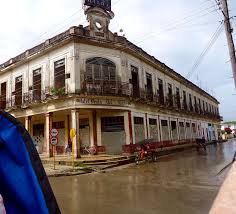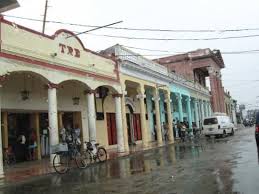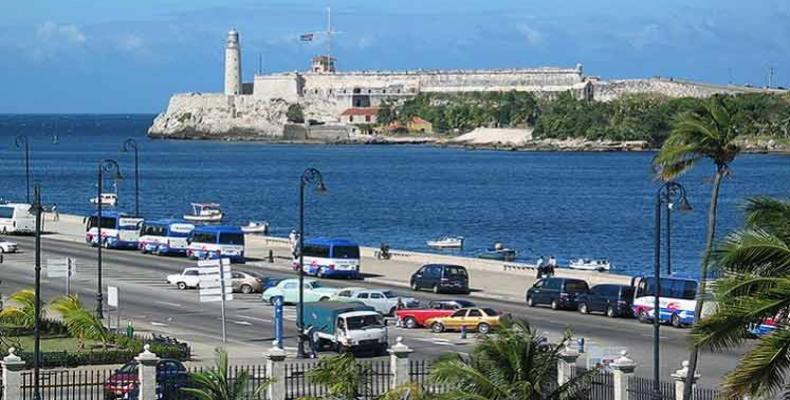
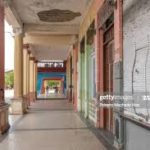
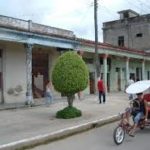 THE CITY OF MORÓN, CUBA, AND ITS TRADITIONAL ROOSTER. PHOTOS.
THE CITY OF MORÓN, CUBA, AND ITS TRADITIONAL ROOSTER. PHOTOS.
Morón is a city and a municipality in Ciego de Ávila Province in central Cuba. It is one of ten municipalities in the province and is the second in importance and the oldest.
REAL STORY OF THE MORON ROOSTER.
The popular phrase among Cubans “you stayed or they left you like the Rooster of Morón, without feathers and cackling”, many will think that it has its origin in the famous monument of the rooster in Morón, province of Ciego de Ávila.
But it turns out that the original story has nothing to do with Cuba, nor with a real rooster.
The legend of the true Rooster of Morón dates back to the 16th century, in Morón de la Frontera, the current province of Seville. Ancient Spanish history begins with the arrival in this city of the Granada tax collector.
Because of his rude way of acting and repeating the phrase “where this rooster sings, no other sings” the villagers baptized him as the Rooster of Morón.
But as the bad attitude of the tax collector worsened, the Moronenses could not hold out any longer and gave him a good kick in, as we say in Cuba. The man left without worrying about what would happen to the taxes.
For its part, in the 18th century in the Cuban city of Morón, there was a large community of Spanish origin, so the legend of the rooster came to our land. In this way, the animal became the symbol of the town.
The city began to be known, first as the “Land of the Rooster” and later as the “City of the Rooster”.
It is contradictory since the rooster of Cuba was always represented with feathers, a big difference from the original plucked legend.
As the first statue was inaugurated by Fulgencio Batista, after the triumph of the Cuban Revolution it was removed and replaced several times, in the midst of the struggle between detractors and followers.
Eventually, he won the idea that the rooster represents much more to the people than who put it there. The current sculpture is authored by renowned Cuban artists Rita Longa and Armando Alonso, who incidentally was the author of the first rooster.
GEOGRAPHY.
The municipality is located north of the city of Ciego de Ávila, bordering the Bolivia municipality to the east, Chambas to the west, the Bay of Buena Vista, and the Jardines del Rey to the north, and the Ciro Redondo municipality to the south. The terrain is mostly plain, with small hills to the north, made up of salt domes. The north shore is covered by marshes.
Morón has the largest natural water mirror in Cuba, Laguna de Leche, of 67.2 km2 (25.9 sq mi). Cayo Coco and Cayo Guillermo, two of the cays of Jardines del Rey archipelago is located north of Morón, across the Bay of Dogs (Bahia Perros).
Previously the municipality was much larger, being one of nine in the previous province of Camagüey. In 1943, it was divided into the barrios of Coronel Hernández, Chambas, Cupeyes, Este, Guadalupe, Mabuya, Marroquí, Oeste, Punta Alegre, Ranchuelo, Santa Gertrudis, Simón Reyes o Sandoval and Tamarindo.
HISTORY.
Early history
The first residents of Morón were Creoles from Sancti Spíritus, although among them were also said to be a group of Spanish sailors who, having navigated all around Cuba, had disembarked nearby and had decided to settle here. They were from Andalusia, in Old Castile, Extremadura, Galicia, and the Canary Islands, among other places.
In the first half of the 20th century, the archipelago and the nearby keys had attained little development. The town of Morón, which started as a community in 1750, survived on a basis of limited, non-mechanized agricultural, and mostly sugar, production. The settlement pattern that prevailed in the coastal areas and keys was that of squatters, people living in very poor, tach-roof, earth floor dwellings, usually not more than five houses together.
Making charcoal and fishing, in many cases, both activities at the same time were apparently the main economic activities on the keys and their surroundings. Fishing was mostly done by using dinghies moved by sticks, oars, or small sails, which did not allow them to venture out of the key shelf. These means we’re the ones used also to reach the mainland and to transport products out. In the settlements, livestock was mostly limited to a few animals. Still standing at some places are remains of the stone fences that were used to confine the animal.
Living conditions here were in general very difficult, due mostly to the remoteness of the area and the lack of proper means of transportation. Transportation consisted usually of a small sailboat that traveled back and forth once a month, and whose journey took many hours, Reaching the mainland from Cayo Coco, for example, took around 10 hours, in addition to the risks that had to be run at sea.
During Cuba’s 1st War of Independence in 1869, the town of Morón became the northern end of the line of forts, the Trocha from Júcaro to Morón built by the Spanish to contain Cuban rebels on the eastern end of the island. The Trocha also included a railroad line to move troops and supplies, the first government railroad line in Cuba.
RECENT HISTORY.
The town of Morón began to grow in 1915 when the Trocha rail line was bought by Colonel Jose M. Tarafa as he began to assemble the Ferrocarriles del Norte railway line. Morón was chosen as the line’s headquarters. The railway’s maintenance shops and a large central station became the central feature of the town. Morón became the junction of a network of several branch lines and sugar lines which stimulated the expansions of sugar plantations and centralized sugar mills which previously were located mainly in the south and central part of Cuba.
In the 1960s a road was built through the marshland to the coast, and in the 1990s this was extended on a man-made causeway to Cayo Coco and Cayo Guillermo, where a number of hotels were built. Many of the hotel workers live in Morón and commute to work in specially provided buses.
ECONOMY.
The main economic activities are agriculture and tourism.
DEMOGRAPHICS.
In 2004, the municipality of Morón had a population of 60,612. With a total area of 615 km2 (237 sq mi), it has a population density of 98.6/km2 (255/sq mi).
TRANSPORT.
Morón railway station is an important junction point between the lines Santa Clara-Nuevitas, and Júcaro-Ciego de Ávila-Morón. The northern state highway, “Circuito Norte” (CN), passes through the city; and the main road from Ciego de Ávila to Cayo Coco also skirts it.
Jardines del Rey Airport, located in Cayo Coco, serves the municipality. It replaces the former Cayo Coco Airport, demolished in 2002.
NOTABLE RESIDENTS.
Pío Leyva (1917-2006), singer
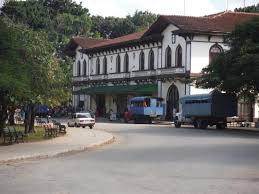 CIUDAD DE MORÓN, CUBA Y LA VERDADERA HISTORIA DE SU TRADICIONAL GALLO. PHOTOS.
CIUDAD DE MORÓN, CUBA Y LA VERDADERA HISTORIA DE SU TRADICIONAL GALLO. PHOTOS.
Morón es una ciudad y un municipio de la provincia de Ciego de Ávila en el centro de Cuba. Es uno de los diez municipios de la provincia y es el segundo en importancia y el más antiguo.
HISTORIA VERDADERO DEL GALLO DE MORÓN.
La popular frase entre los cubanos “te quedaste o te dejaron como el Gallo de Morón, sin plumas y cacareando”, muchos pensarán que tiene su origen en el famoso monumento del gallo en Morón, provincia de Ciego de Ávila.
Pero resulta que la historia original no tiene nada que ver con Cuba, ni con un gallo de verdad.
La leyenda del verdadero Gallo de Morón se remonta al siglo XVI, en Morón de la Frontera, actual provincia de Sevilla. La historia de la antigua España comienza con la llegada a esta ciudad del recaudador de impuestos de Granada.
Por su forma ruda de actuar y de repetir la frase “donde canta este gallo, no canta otro” los pobladores lo bautizaron como el Gallo de Morón.
Pero a medida que empeoraba la mala actitud del recaudador de impuestos, los moronenses no aguantaron más y le dieron una buena patada, como decimos en Cuba. El hombre se fue sin preocuparse por lo que pasaría con los impuestos.
Por su parte, en el siglo XVIII en la ciudad cubana de Morón, existía una gran comunidad de origen español, por lo que la leyenda del gallo llegó a nuestra tierra. De esta forma, el animal se convirtió en el símbolo del pueblo.
La ciudad comenzó a ser conocida, primero como la “Tierra del Gallo” y luego como la “Ciudad del Gallo”.
Es contradictorio ya que el gallo de Cuba siempre estuvo representado con plumas, una gran diferencia con la leyenda original desplumada.
Como la primera estatua fue inaugurada por Fulgencio Batista, tras el triunfo de la Revolución Cubana fue removida y reemplazada varias veces, en medio de la pugna entre detractores y seguidores.
Finalmente, ganó la idea de que el gallo representa mucho más para la gente que quién lo puso allí. La escultura actual es de la autoría de los reconocidos artistas cubanos Rita Longa y Armando Alonso, quien por cierto fue el autor del primer gallo.
GEOGRAFÍA.
El municipio se ubica al norte de la ciudad de Ciego de Ávila, colindando con el municipio de Bolivia al este, Chambas al oeste, la Bahía de Buena Vista y los Jardines del Rey al norte, y el municipio de Ciro Redondo al sur. El terreno es mayormente llano, con pequeñas colinas al norte, formadas por domos de sal. La costa norte está cubierta por marismas.
Morón tiene el espejo de agua natural más grande de Cuba, Laguna de Leche, de 67,2 km2 (25,9 millas cuadradas). Cayo Coco y Cayo Guillermo, dos de los cayos del archipiélago Jardines del Rey se encuentran al norte de Morón, al otro lado de la Bahía de los Perros (Bahía Perros).
Anteriormente el municipio era mucho más grande, siendo uno de los nueve de la anterior provincia de Camagüey. En 1943 se dividió en los barrios de Coronel Hernández, Chambas, Cupeyes, Este, Guadalupe, Mabuya, Marroquí, Oeste, Punta Alegre, Ranchuelo, Santa Gertrudis, Simón Reyes o Sandoval y Tamarindo.
HISTORIA.
Historia temprana
Los primeros habitantes de Morón fueron criollos de Sancti Spíritus, aunque entre ellos también se decía que estaba un grupo de marineros españoles que, habiendo navegado por toda Cuba, habían desembarcado cerca y habían decidido instalarse aquí. Eran de Andalucía, Castilla la Vieja, Extremadura, Galicia, Canarias, entre otros lugares.
En la primera mitad del siglo XX, el archipiélago y los cayos cercanos habían alcanzado poco desarrollo. El pueblo de Morón, que comenzó como una comunidad en 1750, sobrevivió sobre la base de una producción agrícola limitada, no mecanizada y principalmente azucarera. El patrón de asentamiento que prevaleció en las áreas costeras y cayos fue el de ocupantes ilegales, personas que viven en viviendas muy pobres, con techo de tacómetro y piso de tierra, generalmente no más de cinco casas juntas.
La fabricación de carbón y la pesca, en muchos casos, ambas actividades al mismo tiempo, aparentemente fueron las principales actividades económicas en los cayos y sus alrededores. La pesca se realizaba principalmente con botes movidos por palos, remos o pequeñas velas, lo que no les permitía aventurarse fuera del estante de llaves. Esto significa que somos los que estamos acostumbrados también a llegar al continente y transportar productos. En los asentamientos, el ganado se limitaba principalmente a unos pocos animales. Todavía en pie en algunos lugares quedan restos de las vallas de piedra que se utilizaron para confinar al animal.
Las condiciones de vida aquí eran en general muy difíciles, principalmente debido a la lejanía de la zona y la falta de medios de transporte adecuados. El transporte consistía generalmente en un pequeño velero que viajaba de ida y vuelta una vez al mes, y cuyo viaje tomaba muchas horas, Llegar al continente desde Cayo Coco, por ejemplo, tomaba alrededor de 10 horas, además de los riesgos que había que correr en el mar.
Durante la Primera Guerra de Independencia de Cuba en 1869, la ciudad de Morón se convirtió en el extremo norte de la línea de fuertes, la Trocha de Júcaro a Morón construida por los españoles para contener a los rebeldes cubanos en el extremo oriental de la isla. La Trocha también incluyó una línea de ferrocarril para mover tropas y suministros, la primera línea de ferrocarril del gobierno en Cuba.
HISTORIA RECIENTE.
El pueblo de Morón comenzó a crecer en 1915 cuando el Coronel José M. Tarafa compró la línea del ferrocarril Trocha al comenzar el montaje de la línea Ferrocarriles del Norte. Morón fue elegido como sede de la línea. Los talleres de mantenimiento del ferrocarril y una gran estación central se convirtieron en el elemento central de la ciudad. Morón se convirtió en la unión de una red de varios ramales y líneas azucareras que estimularon las expansiones de los ingenios azucareros y centrales azucareras que antes se ubicaban principalmente en el sur y centro de Cuba.
En la década de 1960 se construyó una carretera a través de la marisma hasta la costa, y en la década de 1990 se amplió en una calzada artificial hacia Cayo Coco y Cayo Guillermo, donde se construyeron varios hoteles. Muchos de los trabajadores del hotel viven en Morón y viajan al trabajo en autobuses especiales.
ECONOMÍA.
Las principales actividades económicas son la agricultura y el turismo.
DEMOGRAFÍA.
En 2004, el municipio de Morón tenía una población de 60.612 habitantes. Con una superficie total de 615 km2 (237 millas cuadradas), tiene una densidad de población de 98,6 / km2 (255 / mi2).
TRANSPORTE.
La estación de trenes de Morón es un importante punto de unión entre las líneas Santa Clara-Nuevitas y Júcaro-Ciego de Ávila-Morón. La carretera estatal del norte, “Circuito Norte” (CN), pasa por la ciudad; y la carretera principal de Ciego de Ávila a Cayo Coco también la bordea.
El Aeropuerto Jardines del Rey, ubicado en Cayo Coco, atiende al municipio. Reemplaza al antiguo Aeropuerto de Cayo Coco, demolido en 2002.
RESIDENTES DESTACADOS.
Pío Leyva (1917-2006), cantante
Agencies/ WIki/ Internet Photos/ Arnoldo Varona/ www.TheCubanHistory.com
THE CUBAN HISTORY, HOLLYWOOD.




